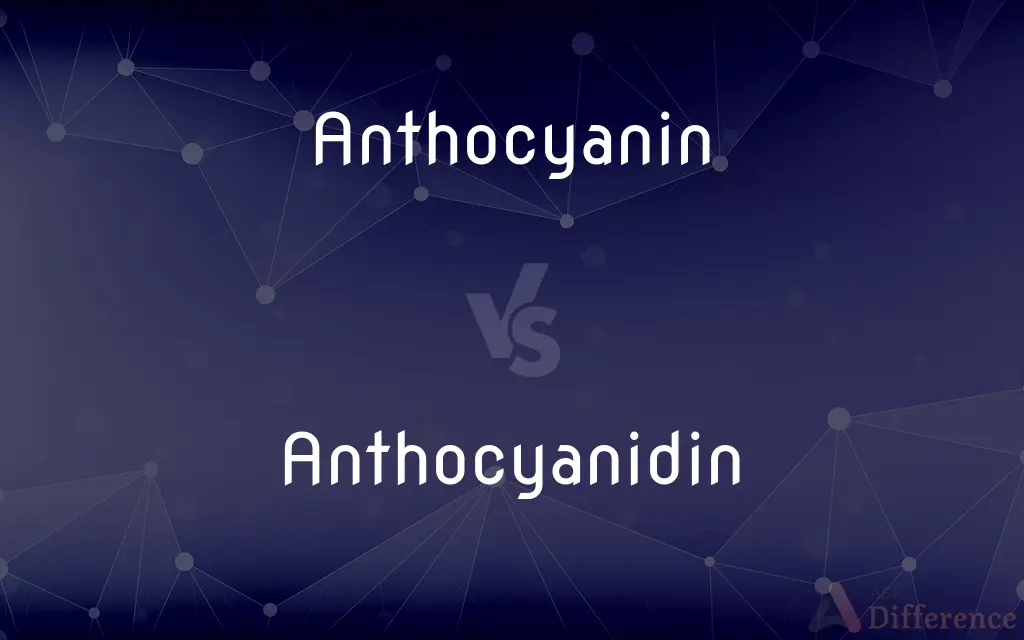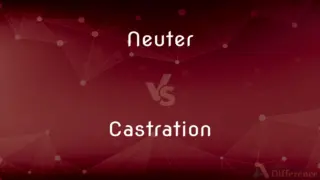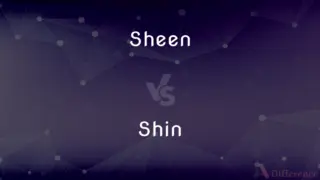Anthocyanin vs. Anthocyanidin — What's the Difference?
By Tayyaba Rehman — Updated on September 23, 2023
Anthocyanin is a water-soluble pigment found in plants, often responsible for red, purple, and blue hues. Anthocyanidin refers to the aglycone part of the anthocyanin molecule, without sugar.

Difference Between Anthocyanin and Anthocyanidin
Table of Contents
ADVERTISEMENT
Key Differences
Anthocyanin and Anthocyanidin are both crucial terms in the study of plant pigmentation, yet they reference different components of the pigments themselves. Anthocyanin denotes a group of water-soluble pigments found in many plants, particularly in the tissues of flowers, fruits, and leaves. These pigments are responsible for the vibrant red, blue, and purple hues we see in various plant parts.
Anthocyanidin, in contrast, specifically points to the core structure of the anthocyanin pigment without any attached sugar molecules. Essentially, when the sugar is removed from an anthocyanin, the resultant molecule is termed anthocyanidin. These anthocyanidins, once they bind with sugars, form the stable and water-soluble anthocyanins.
Both anthocyanins and anthocyanidins play significant roles in plant biology. While anthocyanins have a more direct role in coloring and attracting pollinators, anthocyanidins contribute by forming the backbone of these pigments. It's fascinating to note that despite being the core structure, anthocyanidins on their own are less stable and less common than their sugar-bound counterparts, anthocyanins.
From a human health perspective, anthocyanins have drawn attention for their potential antioxidant properties. Whether in berries or red cabbage, the presence of these compounds suggests possible health benefits. Anthocyanidins, being the core, indirectly contribute to these benefits. Still, it's the full anthocyanin molecule that interacts in nutritional contexts.
Comparison Chart
Nature
Water-soluble pigment in plants
Core structure of anthocyanin without sugar
ADVERTISEMENT
Presence
Found in flowers, fruits, and leaves
Less common in nature
Stability
Stable due to attached sugar
Less stable
Function
Coloring, potential antioxidant
Provides the basic structure for anthocyanins
Association
Comprises both sugar and anthocyanidin components
Does not include sugar molecules
Compare with Definitions
Anthocyanin
Comprises sugar and anthocyanidin components.
The molecular structure of anthocyanin includes sugar, making it soluble and stable.
Anthocyanidin
Forms the backbone of the pigment anthocyanin.
Anthocyanidin provides the foundational structure to which sugars attach in anthocyanin.
Anthocyanin
Has potential antioxidant properties in nutritional contexts.
Studies suggest that anthocyanin might have health benefits when consumed.
Anthocyanidin
Less stable than anthocyanins.
Without the sugar molecule, anthocyanidin lacks the stability seen in anthocyanin.
Anthocyanin
A water-soluble pigment found in many plants.
The deep purple of some grapes is due to the presence of anthocyanin.
Anthocyanidin
The aglycone part of the anthocyanin molecule.
Anthocyanidin is the core structure, devoid of any sugar.
Anthocyanin
Responsible for the red, blue, and purple hues in plants.
The color change in autumn leaves can be attributed to anthocyanin.
Anthocyanidin
Does not include sugar molecules in its structure.
The difference between anthocyanin and anthocyanidin lies in the sugar component, absent in the latter.
Anthocyanin
Often found in tissues of flowers, fruits, and leaves.
Berries contain a high concentration of anthocyanin, giving them their vivid colors.
Anthocyanidin
Less commonly found in nature compared to anthocyanins.
Pure anthocyanidin is rarer in plants than its sugar-bound counterpart.
Anthocyanin
Anthocyanins (also anthocyans; from Greek: ἄνθος (anthos) "flower" and κυάνεος/κυανοῦς kyaneos/kyanous "dark blue") are water-soluble vacuolar pigments that, depending on their pH, may appear red, purple, blue, or black. In 1835, the German pharmacist Ludwig Clamor Marquart gave the name Anthokyan to a chemical compound that gives flowers a blue color for the first time in his treatise “Die Farben der Blüthen”.
Anthocyanidin
Anthocyanidins are common plant pigments, the sugar-free counterparts of anthocyanins. They are based on the flavylium cation, an oxonium ion, with various groups substituted for its hydrogen atoms.
Anthocyanin
Any of various flavonoid glycoside pigments that impart red, purple, and blue colors to plant parts and are found in berries and other fruits, red wine, and certain vegetables.
Anthocyanidin
(organic chemistry) An aglycone of an anthocyanin.
Anthocyanin
Any of many water-soluble red to violet plant pigments related to the flavonoids (more noticeable in autumn after the chlorophyll decomposes)
Anthocyanin
Same as Anthokyan.
Common Curiosities
Can we find pure anthocyanidin in plants?
Anthocyanidin is less commonly found in nature; it's usually seen as part of the anthocyanin molecule.
Why are anthocyanins important for plants?
Anthocyanins give plants their vibrant colors, attracting pollinators and protecting against UV radiation.
How stable are anthocyanidins in nature?
Anthocyanidins are less stable than anthocyanins, which is why they are rarer.
What is anthocyanin?
Anthocyanin is a water-soluble pigment in plants responsible for red, blue, and purple hues.
How does anthocyanidin differ from anthocyanin?
Anthocyanidin is the core structure of anthocyanin without any attached sugar.
Do anthocyanins offer health benefits?
Yes, anthocyanins are studied for their potential antioxidant and other health benefits.
Are anthocyanins water-soluble?
Yes, anthocyanins are water-soluble due to their sugar component.
What colors are typically associated with anthocyanins?
Anthocyanins are often associated with red, blue, and purple hues in plants.
Why is anthocyanidin considered the backbone of anthocyanin?
Anthocyanidin forms the core structure to which sugars attach, creating anthocyanin.
What's the role of sugar in anthocyanins?
Sugar increases the solubility and stability of anthocyanins in plants.
What foods are rich in anthocyanins?
Foods like berries, red grapes, and red cabbage are rich in anthocyanins.
Do anthocyanins have nutritional value?
Yes, besides coloring, anthocyanins have potential antioxidant properties beneficial for health.
Are anthocyanins and anthocyanidins the only pigments in plants?
No, while they are common, there are other pigments like chlorophyll and carotenoids in plants.
Are anthocyanidins directly responsible for plant colors?
No, anthocyanidins provide the core structure, but anthocyanins, with their sugars, provide the colors.
Are anthocyanins found in all plants?
No, anthocyanins are found in specific plants, especially those with red, blue, or purple hues.
Share Your Discovery

Previous Comparison
Neuter vs. Castration
Next Comparison
Sheen vs. ShinAuthor Spotlight
Written by
Tayyaba RehmanTayyaba Rehman is a distinguished writer, currently serving as a primary contributor to askdifference.com. As a researcher in semantics and etymology, Tayyaba's passion for the complexity of languages and their distinctions has found a perfect home on the platform. Tayyaba delves into the intricacies of language, distinguishing between commonly confused words and phrases, thereby providing clarity for readers worldwide.















































